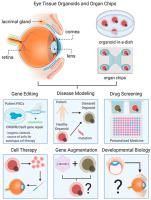The Ocular Surface ( IF 5.9 ) Pub Date : 2020-11-18 , DOI: 10.1016/j.jtos.2020.11.004 Navid Manafi 1 , Fereshteh Shokri 2 , Kevin Achberger 3 , Masatoshi Hirayama 4 , Melika Haji Mohammadi 5 , Farsad Noorizadeh 6 , Jiaxu Hong 7 , Stefan Liebau 3 , Takashi Tsuji 8 , Peter M J Quinn 9 , Alireza Mashaghi 5

|
Recent advances have driven the development of stem cell-derived, self-organizing, three-dimensional miniature organs, termed organoids, which mimic different eye tissues including the retina, cornea, and lens. Organoids and engineered microfluidic organ-on-chips (organ chips) are transformative technologies that show promise in simulating the architectural and functional complexity of native organs. Accordingly, they enable exploration of facets of human disease and development not accurately recapitulated by animal models. Together, these technologies will increase our understanding of the basic physiology of different eye structures, enable us to interrogate unknown aspects of ophthalmic disease pathogenesis, and serve as clinically-relevant surrogates for the evaluation of ocular therapeutics. Both the burden and prevalence of monogenic and multifactorial ophthalmic diseases, which can cause visual impairment or blindness, in the human population warrants a paradigm shift towards organoids and organ chips that can provide sensitive, quantitative, and scalable phenotypic assays. In this article, we review the current situation of organoids and organ chips in ophthalmology and discuss how they can be leveraged for translational applications.
中文翻译:

眼科器官和器官芯片
最近的进展推动了干细胞衍生的,自组织的三维微型器官(称为类器官)的发展,该器官模仿了包括视网膜,角膜和晶状体在内的不同眼部组织。类器官和工程化的微流体芯片上器官(organ chip)是一种变革性技术,在模拟天然器官的结构和功能复杂性方面显示出希望。因此,它们能够探索动物模型无法准确概括的人类疾病和发展的各个方面。这些技术在一起将增进我们对不同眼睛结构的基本生理学的理解,使我们能够询问眼科疾病发病机理的未知方面,并可以作为临床相关的评估眼科治疗药物的替代物。可能导致视力障碍或失明的单基因和多因素眼科疾病的负担和患病率都证明了向类器官和器官芯片的范式转变,可以提供灵敏,定量和可扩展的表型分析。在本文中,我们回顾了眼科学中类器官和器官芯片的现状,并讨论了如何利用它们来进行翻译应用。











































 京公网安备 11010802027423号
京公网安备 11010802027423号